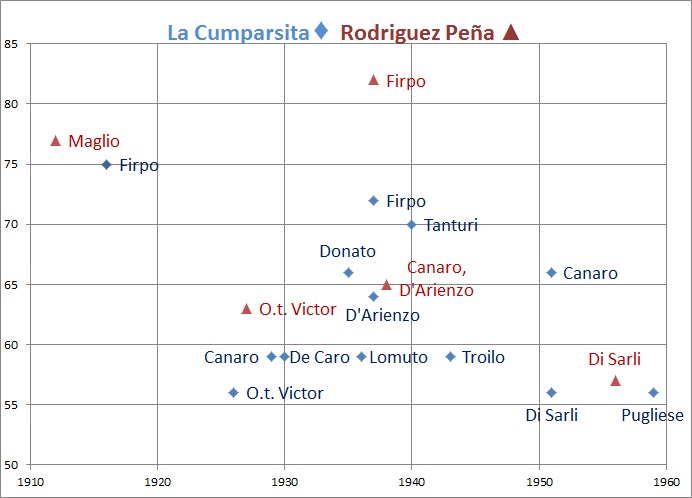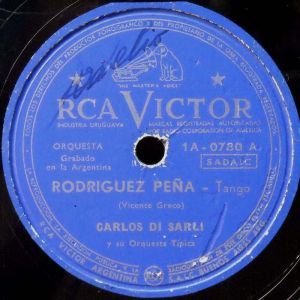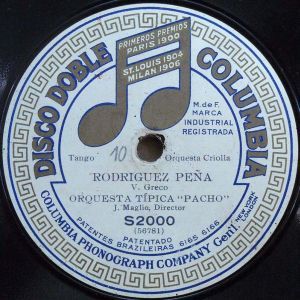Dancers often speak of “high energy” and “low energy” tangos, but what do they mean by energy? Is it something proportionate to the amount of sweat they perspire during dancing or is it something mystic, kind of an astral body of music? My approach here is neither that physical nor that spiritual. Instead, I’ll concentrate on a measurable, perceptional phenomenon that highly contributes to one’s experience of the energy of music.
There are many factors that affect your sensation of music. The basic thing that dictates the feeling of liveliness vs. calmness or lightness vs. heaviness more than anything else is, of course, tempo, i.e. the simple beats-per-minute rate of the musical pulse. Because tango, like many other genres of dance music, has a regular beat and because the rate of this beat does not vary much during one performance, average tempo can be conveniently expressed by just a single number.
It’s quite obvious that tangos that are considered “high energy” (like those played by D’Arienzo) often have higher tempo rates than tangos on the average, but I’m not interested in classifying tango performances according to energy level. What really interests me is treating tempo as a stylistic feature that varies in time and in relation to the performer. One might think that for a given musical composition, there is an optimal tempo in which it should be performed, but that’s not the case. One of the characteristics of a live music culture is that well-known themes, forms or standards are re-interpreted over and over again. In this post I’m going to follow the footprints of two tango standards.
I have chosen two Guardia Vieja tangos: Rodríguez Peña by Vicente Greco, composed in 1911, and La Cumparsita, the paragon of tango all over the world, composed by Gerardo Matos Rodríguez and augmented by Roberto Firpo in 1916. My material is not very extensive, but I think it shapes a good outline.
So I measured the average tempo of a number of recordings and placed the results on an x-y graph. The x axis represents the year of recording and the y axis the average tempo in beats per minute for a quarter note.

What do we see here? For starters, the oldest performances by Juan Maglio and Roberto Firpo are very fast – in fact so fast that they can be danced as a milonga. In addition, if you listen to Rodríguez Peña, you will hear a clear Habanera rhythm, which is considered typical of the milonga but also prevalent with tangos of the period. This is because tango and milonga were not musically differentiated at that time.
After the first two performances there is a large gap before the next ones in the late 1920’s. I’m not sure why recordings from this period are not available – maybe because nobody was interested in republishing mechanical recordings from the early 20’s when electric recordings from the late 20’s sounded much better. Anyway, when we listen to the first electric recordings by Orquesta Típica Victor, we immediately hear that something dramatic has happened: The tempos have dropped by 20 to 25 per cent, and the Habanera rhythm is totally gone. Also the bands have been reorganized: flute and guitar have been dropped while piano and bandoneon have stabilized their position. All in all, the gap marks the end of Guardia Vieja (ca. 1880 to 1920), and Tango, as we know it, has been born!
The late 1920’s and early 1930’s are a period of relatively slow tempos, but around 1935 something happens again. D’Arienzo starts his “energetic” revolution, and even Canaro goes with him, at least in tempo. Donato has always played in lively tempos, and his Cumparsita is no exception. Tanturi makes it even better, but Firpo, in his splendid isolation, goes back to Guardia Vieja tempos or even beyond. His Rodríguez Peña (1937, 82 bpm) is no tango anymore. It exceeds the average tempo of new milongas of the period, and even the Habanera rhythm is there, again.
From 1935 on a stylistic differentiation takes place and three separate lines in regard to tempo begin to emerge:
1. Lively tempos: D’Arienzo, Canaro
2. Moderate tempos: Troilo and many others
3. Slow tempos: Di Sarli, Pugliese
So we have seen that from 1912 to 1935 the changes in tempo are regulated by general development in tango music style, but from 1935 on the artistic choices of the band leaders split this uniformity and create the diversity and richness of tango music styles that dancers can enjoy even today. Knowing this it seems no coincidence that the period from 1935 to 1944 is called the Golden Decade of Tango. Thanks to this decade, JD’s and dancers will be able to choose between “high energy” and “low energy” tangos, whatever they feel appropriate.
A Spotify playlist containing all the recordings mentioned in this post is available at A Short History of Tempo.

